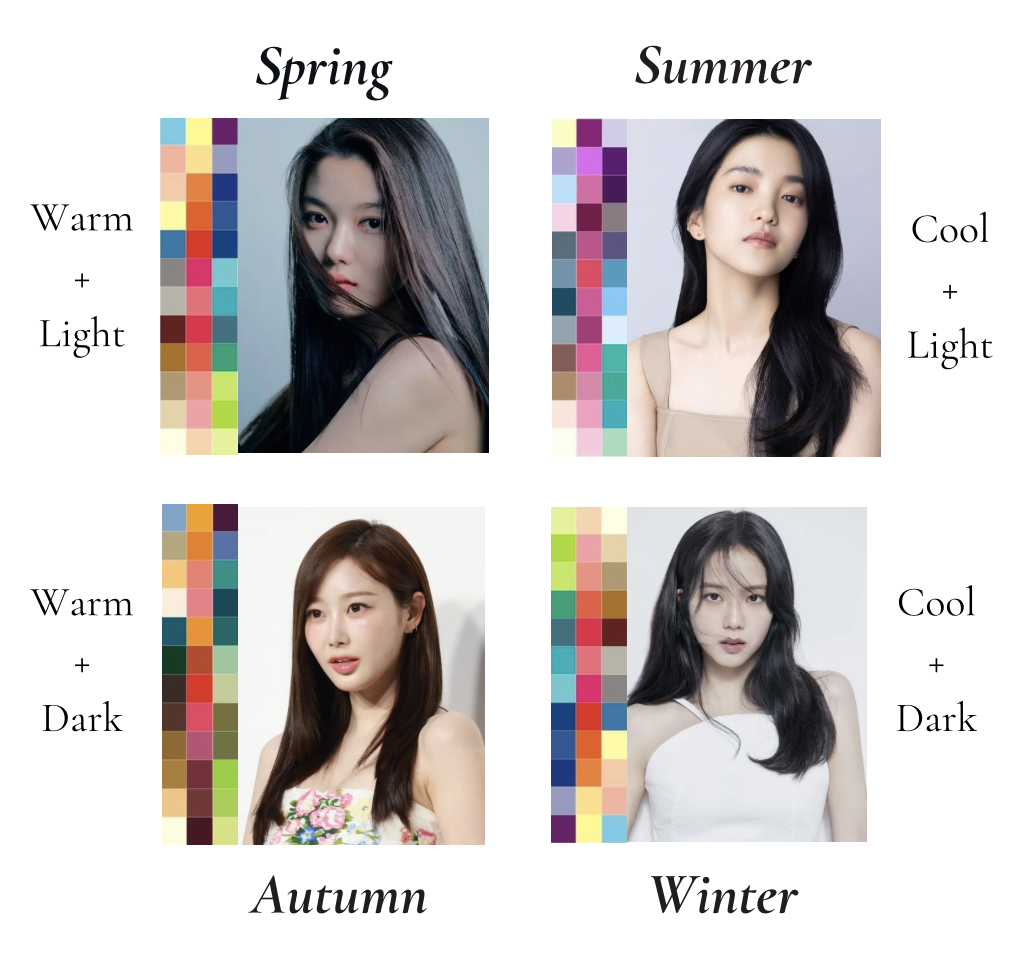The Complete Guide to Asian Colour Analysis: Korean, Japanese & Chinese
Colour analysis isn’t new, Japan’s been doing it since the 1980s, and China’s had its own version for years. But then came K-pop, and everything changed.
Korean idols started having their personal colour tests shared online, fans suddenly knew if their fave was a “Bright Winter” or a “Clear Spring.” One of the biggest moments? When BLACKPINK’s Jisoo’s colour analysis went viral, sparking a wave of people rushing to find out their own.
Let’s break down the key differences in these different colour analysis systems.
Asian colour analysis keeps the science (undertone, brightness, saturation) but adds cultural context and beauty trends:
🇰🇷 Korean: Makeup-first, interactive, trend-focus
🇯🇵 Japanese: Minimalist, subtle, elegant.
🇨🇳 Chinese: Cultural depth, skin tone charts, and your personal “lucky colours”. HUGE on Red Note.
Korean Colour Analysis – The Global Trendsetter
If you’ve seen fabric drapes and lipstick tests on TikTok, that’s Korean personal colour at work.
How it Works
Uses the 4- or 12-season system (Spring, Summer, Autumn, Winter).
Focuses on makeup: lipstick, blush, hair colours.
Highly interactive — you see the instant “wow” as they swap colours.
The Vibe
Playful, fun, and very shareable.
Like a makeover party, not a science lecture.
Why Clients Love It
Immediate results.
Finding out which Kpop artist(s) have the same seasonal colour as themselves
Feels like a mini beauty glow-up session.
Japanese Colour Analysis – Minimalist Precision
In Japan, colour analysis is softer and subtler — think “quiet luxury.”
How it Works
Often uses the 4/12-season system too, but:
Focuses on harmony and transitions (no harsh “don’t wear this” rules).
Prefers subtle palettes and effortless blending.
The Vibe
Understated elegance.
Soft muted tones, delicate colour coordination.
Why Clients Love It
Perfect for people who love muted palettes and minimalism.
Less “trend” — more “timeless refinement.”
Chinese Colour Analysis – Cultural Depth Meets Modern Style
On 小红书 (Red Note), colour analysis is huge. But in China, it’s not just about looking good, it’s also about cultural meaning and skin tone identity.
How it Works
Blends Korean-style draping + Western structure (4/12-seasons).
Some will add in Feng Shui concepts, an added cultural layer, “life coaching meets styling”:
Colours linked to Five Elements (Wu Xing): Wood, Fire, Earth, Metal, Water.
Lucky colours tied to energy, balance, and confidence.
This can make colour analysis feel personal AND culturally significant for Chinese clients.
Chinese Skin Tone Charts – Yellow toned, fair toned, deep toned (黄皮, 白皮, 黑皮 )
Unlike many Western systems that assume everyone is “cool” or “warm,” Chinese colour analysis is laser-focused on Asian skin tones.
The Big Three:
黄皮 (Huang Pi) – Yellow-toned skin.
Most common in East Asia.
Can be cool yellow (冷黄) or warm yellow (暖黄).
白皮 (Bai Pi) – Fair, pale skin.
Often linked to luxury & prestige in Chinese beauty ideals.
Can be cool white (冷白) or warm white (暖白).
黑皮 (Hei Pi) – Deeper, tanned skin.
Growing recognition & celebration of darker tones in modern styling.
These subcategories guide:
Which makeup shades brighten vs. dull you.
Whether gold or silver jewellery works best.
Which “lucky” colours (e.g., red for energy, jade green for balance) are best to wear for important moments.
Why Clients Love It
Feels hyper-personal — not just “you’re warm” but “you’re a cool yellow who shines in icy jade.”
Taps into cultural pride and modern beauty trends.
People always wonder why do results differ?
Because colour analysis is not like maths. Two analysts can see you under the exact same drapes and decide:
Analysis A: “You’re a Soft Summer.”
Analysis B: “You’re a Muted Spring.”
Both can be “right”, because the analysis is filtered through perspective.
Taste matters
Some stylists love muted, chic palettes, some love bright, bold looks. Their taste shapes which colours they emphasise for you.
Cultural bias matters
A Korean stylist might lean into idol-style colours (fresh pinks, bright blushes).
A Japanese stylist might choose subtle, harmonious tones (soft greys, muted pastels).
A Chinese stylist might include “lucky colours” or colours linked to skin tone charts (Yellow toned, fair toned, deep toned - 黄皮 / 白皮 / 黑皮).
Trend influence matters
What’s “hot” in makeup & fashion at the moment seeps into analysis:
If dewy peach tones are trending, you might be guided toward them — even if they’re not in your “classic” palette.
If quiet luxury is trending, your stylist might recommend muted neutrals for that polished look.
Client factors matter
Hair dye, a tan, or even the lipstick you wore that day can sway the call.
Which Colour Analysis Do You Actually Need?
The big question! Here’s the real talk:
❌ You don’t need all 24 categories.
❌ You don’t need every cultural layer jammed on top of each other.
✅ You do need something that works for your face, your lifestyle, and your style goals.
Korean: Best if you want beauty-first, quick results (lipstick tests, hair colour guidance).
Japanese: Perfect if you love muted, subtle palettes and an understated vibe.
Chinese: Great if you want a deep-dive into your exact skin tone (yellow skintone / pale skintone / tanned skintone) and colours that tie to cultural meaning.
At MMNine Lab, we don’t just hand you a chart. We translate Korean, Japanese & Chinese colour systems through our taste and cultural awareness, a Stylist’s POV, so you get colours that feel modern, wearable, and you.
If you want to find out your personal colour and the palette that actually works for your face, style, and life, book your consultation with MMNine Lab now. Available online or in-person in Hong Kong & Sydney.



